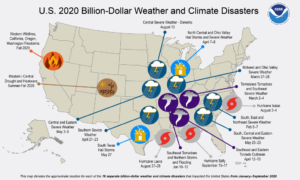
The year 2020 will be noted for some memorable and record-breaking weather.
This year saw the most active and seventh-costliest Atlantic hurricane season on record. There were 13 hurricanes, six major hurricanes and 12 storm systems that made landfall in the U.S., causing 409 deaths and more than $40 billion in damages. Hurricane Laura was the strongest land-falling U.S. hurricane of the season; it hit the Louisiana coast with 150 mph winds and higher than 15 feet of storm surge.
A strong derecho moved through Nebraska, Iowa, Illinois, Wisconsin and Indiana on Aug. 10-11. The storm front moved at an average speed of 55 mph with winds peaking at 110–140 mph. It caused severe damage to corn and soybean crops.
There were 1,022 confirmed tornadoes in the U.S. this year, killing 78 people. This included a widespread and deadly tornado outbreak over the southeastern U.S. on Easter Sunday and the following Monday. There were 20 weak tornadoes in Wisconsin, which climatically has an average of 23 a year.
Between Sept. 28 and Oct. 4, there were 232 waterspouts over the Great Lakes. There was also another waterspout outbreak on the Great Lakes between Aug. 16-18, when the count was 88 spouts. These large outbreaks resulted from a cold Canadian air mass moving over the Great Lakes.
The winter storm that hit the Northeast Dec. 16-17 covered much of Pennsylvania, New York and New England with heavy snow cover. Some cities observed 3 to 4 inches of snow per hour.
The western U.S. experienced a series of major wildfires in 2020. The fires burned more than 8.2 million acres and covered large regions of the U.S. with veils of smoke.
Steve Ackerman and Jonathan Martin, professors in the UW-Madison Department of Atmospheric and Oceanic Sciences, are guests on WHA radio (970 AM) at 11:45 a.m. the last Monday of each month.

